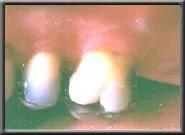The first step of periodontal treatment is the removal of all known and recognizable causative factors. When these are removed, the body has a chance to heal, and the tissue will tend to shrink and tighten against the teeth. This reduces pocket depth, and may be all the treatment needed. Initial preparation may include some or all of the following:
1. Oral Hygiene Instruction
2. Scaling and Root Planing (Deep Cleaning)
3. Removal of Faulty Fillings/Crowns
4. Endodontics (Root Canals)
5. Removal of Hopeless Teeth (Extraction)
6. Removal of Hopeless Roots (Root Resection)
7. Occlusal Equilibration (Bite Adjustment)
8. Minor Tooth Movement (Orthodontics)
9. Stabilization
10. Night Guard
11. Re-evaluation
1.Oral Hygiene Instruction
Personal oral hygiene is the foundation to long-term periodontal health. Few people know how to adequately brush and floss, and home care instruction is important to a successful case. Essentially all periodontal treatment is directly or indirectly focused on plaque reduction, and the more proficient patient plaque control, the better the case result. Remember that learning proper brushing and flossing techniques takes some time and effort, but after several weeks of practice they will become second nature. There is no way to over-emphasize the importance of learning home care skills.
2. Scaling and Root Plaining (Deep Cleaning)
Scaling and root planing is the removal of all hard and soft deposits from the teeth. Scaling usually refers to removal of deposits above the gum line, while root planing refers to removal of deposits on the root itself, below the gum line. Deep cleaning is a lay term generally referring to root planing (under the gum). The soft bacterial deposits that form on tooth surfaces will become hard over time, attaching to the root like a barnacle to a boat hull. These deposits must be removed to eliminate the infection in the gum. Complete scaling and root planing is generally done with local anesthetic ("Novacaine"), and takes from 2 to 6 hours, depending on the case. The deeper the pocket the harder it is to remove all deposits, because of difficulty in seeing and reaching deeper deposits. With deep pockets surgery is the only way to effectively clean the root surfaces.
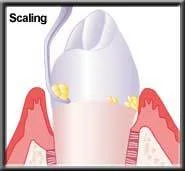
Scaling calculus from the crown of the tooth

Scaling/root planing the root under the gum.
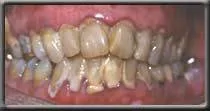
Very heavy soft and hard deposits
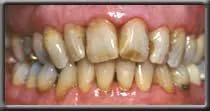
After scaling and root planing
3. Removal of Faulty Fillings/Crowns
Smoothing or removing faulty fillings is needed to prevent shredding of floss, and to remove nooks and crannies where bacteria can hide. Poor restorations can make adequate oral hygiene an impossible task.
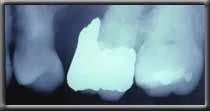
Over contoured filling provides niche for plaque accumulation
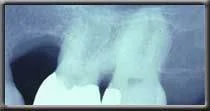
Smoothed filling makes flossing possible
4. Endodontics (Root Canals)
At times it is difficult to tell whether an abscess that forms on the gum's edge is originating from a periodontal pocket, or from an endodontic (root canal) problem. In the latter, the nerve of the tooth has died and infection is draining from the tooth tip out through the gum. If the source of the abscess is a dying nerve, then the gum problem will be corrected by performing a root canal. If the tooth also needs periodontal work, the root canal is usually performed first to help with the periodontal healing. In addition, if a tooth is going to have a root resection, endodontics must be performed before or soon after the procedure.
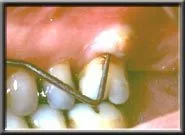
Gum abscess with probe
showing deep pocket

X-ray reveals nerve in
tooth
is dying
5. Removal of Hopeless Teeth (Extraction)
Our purpose is to save teeth. However, if a tooth is very weak, and cannot be saved, extraction may be recommended. This is particularly true if leaving that tooth in may cause an adjacent tooth to be lost from the enlargement of the pocket, or if leaving the tooth will mean less bone support later for partial or implants.
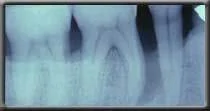
Severe bone loss on front of molar, jeopardizing bone on premolar
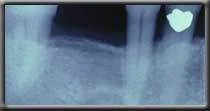
After extraction of molar, complete bone fill of socket and on premolar
6. Removal of Hopeless Roots (Root Resection)
At times one root of a multi-rooted tooth (upper molars have 3 roots, and lower molars have two roots) is hopeless, but the rest of the tooth is healthy. In these cases a root resection may be appropriate, and the hopeless root is removed, while retaining the tooth. Endodontics is always necessary with this procedure, and a crown is generally needed later to strengthen the tooth.
7. Occlusal Equilibration (Bite Adjustment)
If teeth do not hit evenly, some teeth will be subjected to more forces than they can tolerate. Over time these teeth are more susceptible to bone loss. Bite adjustment (occlusal equilibration) smoothes off the high spots and spreads normal chewing forces evenly over all the teeth, so they may function in health.
8. Minor Tooth Movement (Orthodontics)
Teeth that are mal-aligned are difficult to keep clean, cannot take their share of the biting load, and may be unsightly. Minor tooth movement may correct these problems, and create a healthy environment. In some cases, orthodontically moving a tooth may actually reduce pocket depth and lessen the need for periodontal surgery. Using another orthodontic technique, forced tooth eruption, teeth with decay near the bone may be extruded so the decay is visible, helping preserve a cosmetic result by reducing the need for bone recontouring. Generally, these small orthodontic procedures take only a few months to complete. Click to see a clinical case.
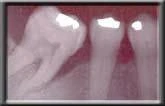
Tipped molar makes cleaning
difficult. Note bone loss on
front
of
tooth
.
9. Stabilization
After minor tooth movement, or if teeth are loose due to bone loss, stabilization may be performed to help tighten the teeth. Two or more teeth are connected together so they may support one another, using crowns, bonding, or other methods.
10. Night Guard
Some patients clench their teeth unconsciously when they sleep. This causes enormous stress on the teeth, and if they are already weakened from periodontal bone loss, can lead to tooth loss. A plastic mouthpiece (night guard) may be worn at night to prevent these excessive forces from harming the teeth.
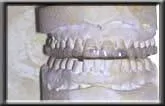

11. Re-evaluation
The last - and most important - step of initial preparation is the re-evaluation. Only then can the dentist determine if the procedures have eliminated or stabilized the disease. During this phase the dentist and patient decide togther if further work is needed, and if so, what treatment would be best. If the case is stable, a maintenance (periodontal cleaning) schedule is determined to keep the periodontal tissue in good health.
